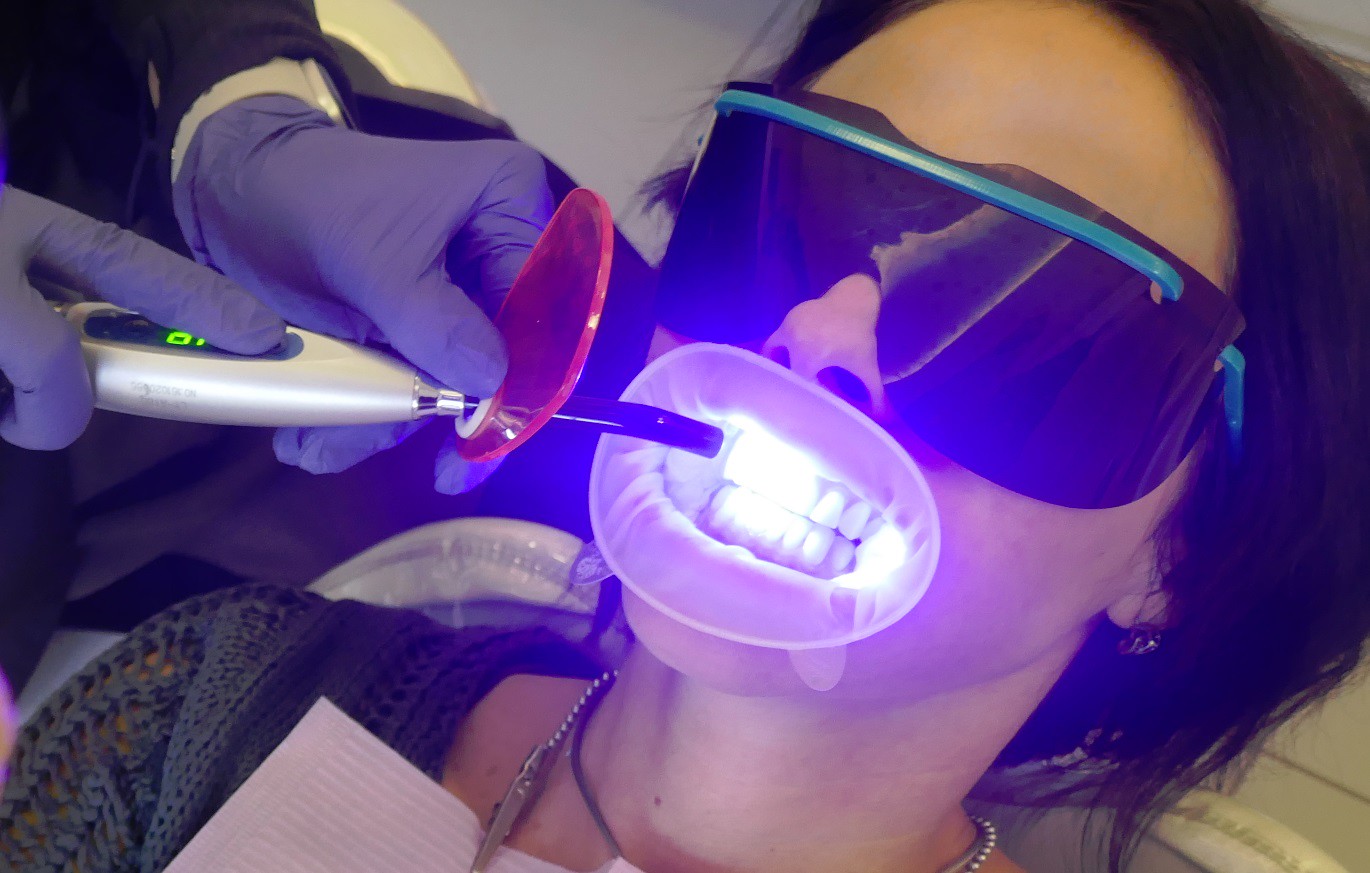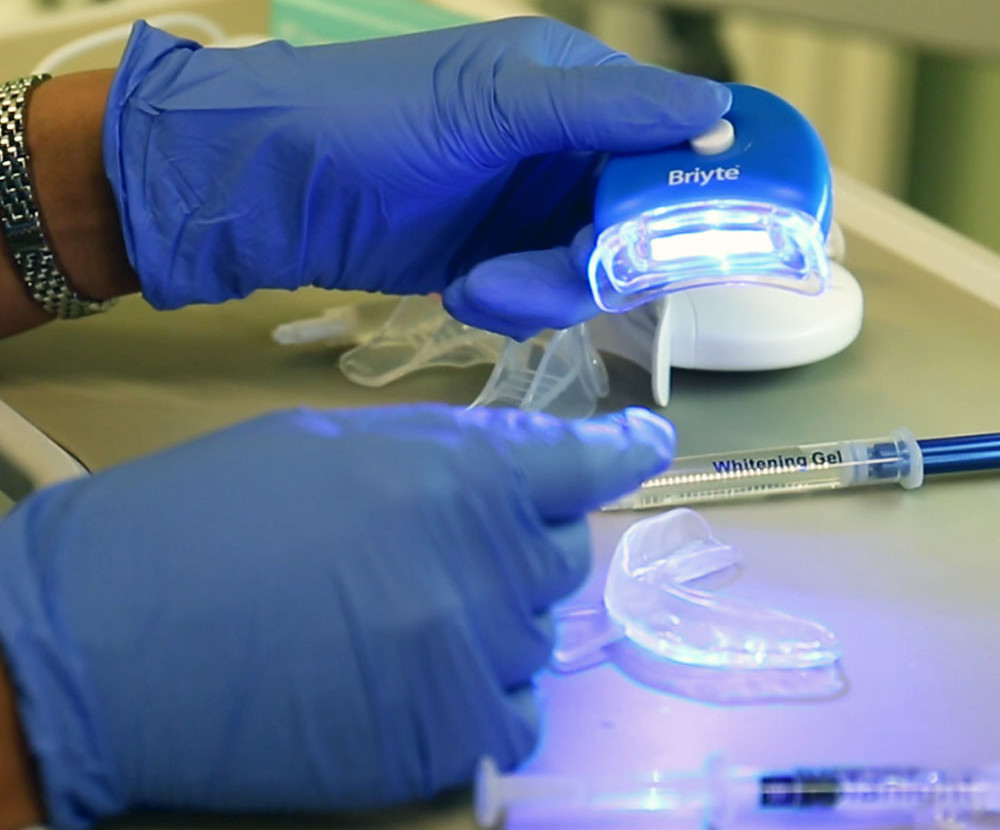Teeth whitening at the dentist, or even with some at-home kits, is often a two-part process. Along with a bleaching agent that is applied to the teeth, an instrument called a curing light is moved over the teeth to help activate the chemicals. Because some curing lights use UV technology (others are halogen or LED), some people wonder if they are safe. After all, exposure to ultraviolet radiation, or UV light, is cited by the American Cancer Society as contributing to skin cancer. Could UV light teeth whitening cause cancer too?
Patients will be relieved to learn that there are no studies showing that light used for teeth whitening causes cancer. But, while cancer is not a concern, there are other reasons to be careful when using whitening tools both with and without light. This is especially true when whitening without a dentist’s supervision.
The Science Behind UV Light Teeth Whitening
UV, halogen, or LED light by itself does nothing to whiten teeth. Hydrogen peroxide or carbamide peroxide solutions are what get rid of stains and lighten teeth. Many products use chemicals alone. Applying light as an extra step activates the molecules in the bleaching agent, with the goal of a faster, longer-lasting change in color.
UV and halogen lights were the first types to be used by dentists for this purpose. They produce heat to accelerate the process. Products like Zoom! whitening uses this method. More recently, LED blue light has become popular. It activates the molecules without radiating heat. Several over-the-counter whitening products have begun including a blue light device with their kits.
Although there is widespread use of light for teeth whitening, there is some debate about how well it works. A study conducted by the National Center for Biotechnology Information concluded that while light showed some enhanced results compared to cases using only chemicals, the difference was not “statistically significant.”
Most dentists and dental product manufacturers feel that light does make a difference. They continue to include it as part of the teeth whitening process.
Teeth Whitening Hazards to Watch For

Even though cancer is not considered a valid concern, there are some other risks associated with UV light teeth whitening. UV instruments are powerful and applying the light for too long or directing it in the wrong spot can damage soft tissues. It can cause sensitivity or even mild burns on the lips, gums, or tongue.
Care must also be taken to protect the eyes while using UV light. Dental technicians, as well as their patients, should use protective eyewear during treatment.
However, if patients experience problems during whitening, it is much more likely to be because of the strong chemicals used rather than the light source. The solutions allowed at the dentist’s office are much stronger than those in store-bought products. Dentists take special care to make sure the peroxide bleaching solution stays on the teeth and away from the gums and lips.
Because of these safety concerns, these strong chemicals and the use of UV and halogen lights for teeth whitening should be left to professionals at a dental practice.
At-Home Teeth Whitening Kits With Lights
Whitening kits that include lights are popping up all over the retail market. The appeal is obvious: these products promise an experience that looks like what is offered at a dentist’s office, for a fraction of the cost. Plus, it gives users the convenience of staying home rather than making several dental appointments for whitening treatment.
Teeth whitening at home is not the same as professional whitening. The chemicals allowed for retail sale are not as strong as those that a dentist uses, and the results aren’t always as noticeable. If there is a light included in a kit, it will be an LED light rather than a UV light. LED is a safer option that has been adopted by many dentists too.
Over-the-counter whitening products might work fine for many people, but they run the risk of making mistakes. They need to follow instructions carefully. Tooth sensitivity and irritation of the gums and lips are common complaints, usually because of leaving solutions on the teeth too long, using them too often, or accidentally letting the chemicals come in contact with soft mouth tissues.
How to Whiten Teeth Safely

The important thing to remember about teeth whitening with or without a light boost is that it is safe as long as it is done correctly. Here are some tips for the safest whitening practices:
- Start with healthy teeth and gums. Applying bleaching agents to teeth with cavities or gums with gingivitis can be painful and make these existing conditions worse. See a dentist for a full checkup before starting any teeth whitening program.
- While getting that checkup, talk to the dentist about the causes and possible solutions for your particular tooth stains. Some stains are permanent and unfortunately can’t be removed by any available method. Dental restorations like crowns and porcelain fillings won’t change color, either.
- When buying at-home whitening products, look for seals of approval from the FDA and the American Dental Association (ADA). It is important to note that while the ADA has data on the safety of UV curing lights used by dentists, they have not published any findings—good or bad—about at-home lights.
- Follow all instructions carefully and do not use at-home products more often or for longer than recommended.
Beware of teeth whitening offered by non-professionals. Salons, spas, and even mall kiosks have begun offering the service. They may be able to get full-strength chemicals and even use UV lights. But these are not dental professionals and there is no guarantee that they have the appropriate training or experience to safely provide this treatment.
Choose a Dental Professional for Teeth Whitening
When whitening teeth, cancer from UV light should not be a concern. The treatment does have risks, however, so it is a good idea to understand the process and keep safety in mind.
The safest option when it comes to whitening teeth is to see a dentist. Dentists use the most effective chemicals and tools such as UV light that will give the best results, and have the expertise to use them properly. With your health and safety as their primary concern, they will protect your teeth and gums while getting your teeth as white as possible. Use our make an appointment tool to find a dentist near you to start the whitening process.


